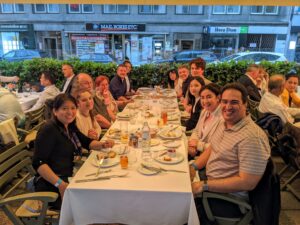The SPECIAL group took part in the annual migration of geoscientists to Vienna for the European Geosciences Union (EGU) General Assembly between the 23rd and 27th May. The EGU General Assembly is Europe’s largest and most prominent geosciences event, incorporating over 12,000 presentations from 7,315 participants on site, as well as an additional 7,002 virtual attendees this year. The SPECIAL group was well represented at the meeting, and for many, including myself, it was a great opportunity to meet a lot of familiar faces (previously seen only in Zoom chats), in person for the first time. The group presented a wide range of recently published and ongoing research projects in the new 5-7 minute format.

Presentations by Sandy Harrison (https://doi.org/10.5194/egusphere-egu22-1217) and Paul Lincoln (https://doi.org/10.5194/egusphere-egu22-7457) highlighted the value of the new Reading Palaeofire Database (RPD) for palaeofire analyses and model evaluation. Paul demonstrated the potential that sedimentary charcoal data from the RPD has for assessing the accuracy of fire model simulations from the Last Glacial Maximum.
Luke Sweeney presented results from his forthcoming paper on the potential for an anthropogenic influence on fire in Iberia during the mid-to- Early Holocene (https://doi.org/10.5194/egusphere-egu22-884). He demonstrated that human influences had a negligible impact on fire regimes, and implied that other influences, such as climatic changes, played a more important role in shaping Iberian fire regimes at the regional scale.
Mark Turner presented his work on the impact of Dansgaard-Oeschger (D-O) events on Mediterranean climate during the last glacial period (https://doi.org/10.5194/egusphere-egu22-4968). Using pollen records to infer hydroclimatic changes, he showed how steep east-west climatic gradients developed over the Mediterranean during the abrupt warming phases of D-O events, which he attributed to northerly shifts in the position of the Atlantic storm tracks.
Esmerelda Cruz-Silva discussed the results of her recently published article on improvements in reconstructing in Mediterranean biomes through the Holocene using pollen records from the EMBSeCBIO database (https://doi.org/10.5194/egusphere-egu21-6518).
Olivia Haas discussed new data used to understand the spatial controls on fire variables (e.g. burnt area, fire size and fire intensity) using generalized linear modelling. (https://doi.org/10.5194/egusphere-egu22-3628). She demonstrated that the fire variables are driven by different controls, and highlighted the importance of factors such as land fragmentation and antecedent vegetation controls (e.g. dryness) in controlling fire regimes.
Theodore Keeping presented initial research on his development and application of a fire hazard model to the United States (https://doi.org/10.5194/egusphere-egu22-3051) in order to improve predictions of wildfire hazards.
Yicheng Shen discussed the initial results of her PhD research into the relationships between resprouting woody vegetation and fire frequency and intensity (https://doi.org/10.5194/egusphere-egu22-1007). She demonstrated a consistent pattern between the decreasing abundance of resprouting woody vegetation with increasing fire return interval and discussed the importance of including these vegetation traits into fire-enabled vegetation models.
Sarah Parker gave a talk in the Speleothem and Continental Carbonate Archives of Modern and Palaeoenvironmental Change session, discussing her investigations into the global speleothem signal of the 8.2ka event (https://doi.org/10.5194/egusphere-egu22-3953). She discussed how this abrupt climatic cooling event is widely recorded in speleothem records and appears to be globally synchronous in time and duration. Different proxy signals of the event however suggests inter-regional hydrological climatic complexity, associated with the well documented rapid cooling signal across the Northern Atlantic seaboard.
Mengmeng Liu presented her work on developing understanding of fractional absorbed photosynthetically active radiation (fAPAR) and tree height changes during D-O events from pollen records to quantify land-surface albedo feedbacks (https://doi.org/10.5194/egusphere-egu22-1292).
Overall, the assembly was really enjoyable, and a great opportunity to meet up with colleagues and friends to discuss ongoing research projects. It was also a valuable and rewarding experience for newer members of the SPECIAL group who, since joining the team, have been unable to meet up in person with their colleagues and collaborators. There was also a great overlap with interested and affiliated members of the Leverhulme centre for Wildfires, Environment and Society as well as the SISAL working group to informally touch base and discuss research plans over a beer and/ or a schnitzel. Hopefully the success of the EGU 2022 general assembly for the SPECIAL team represents the resumption of more collaborations, meetings and social events in person going forward.

